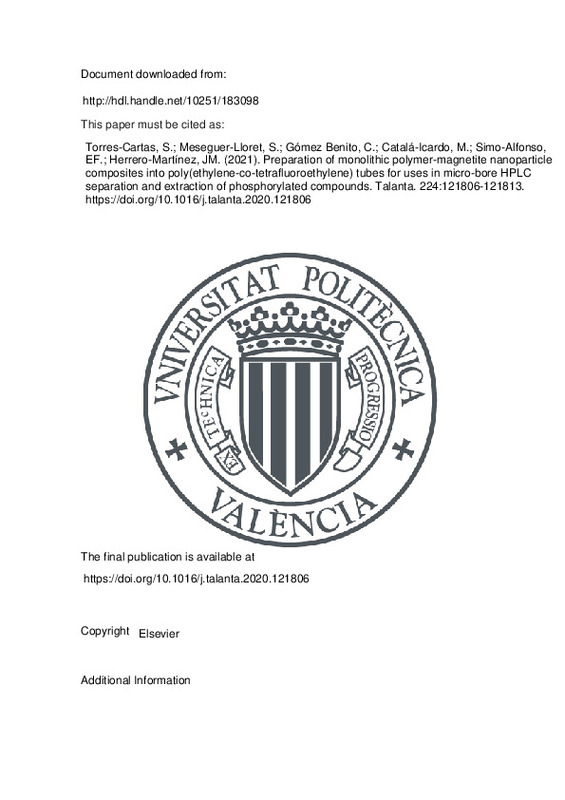JavaScript is disabled for your browser. Some features of this site may not work without it.
Buscar en RiuNet
Listar
Mi cuenta
Estadísticas
Ayuda RiuNet
Admin. UPV
Preparation of monolithic polymer-magnetite nanoparticle composites into poly(ethylene-co-tetrafluoroethylene) tubes for uses in micro-bore HPLC separation and extraction of phosphorylated compounds
Mostrar el registro completo del ítem
Torres-Cartas, S.; Meseguer-Lloret, S.; Gómez Benito, C.; Catalá-Icardo, M.; Simo-Alfonso, EF.; Herrero-Martínez, JM. (2021). Preparation of monolithic polymer-magnetite nanoparticle composites into poly(ethylene-co-tetrafluoroethylene) tubes for uses in micro-bore HPLC separation and extraction of phosphorylated compounds. Talanta. 224:121806-121813. https://doi.org/10.1016/j.talanta.2020.121806
Por favor, use este identificador para citar o enlazar este ítem: http://hdl.handle.net/10251/183098
Ficheros en el ítem
Metadatos del ítem
| Título: | Preparation of monolithic polymer-magnetite nanoparticle composites into poly(ethylene-co-tetrafluoroethylene) tubes for uses in micro-bore HPLC separation and extraction of phosphorylated compounds | |
| Autor: | Simo-Alfonso, Ernesto F. Herrero-Martínez, José Manuel | |
| Entidad UPV: |
|
|
| Fecha difusión: |
|
|
| Resumen: |
[EN] This paper describes the fabrication of a novel microbore monolithic column modified with magnetite nanoparticles (MNPs) prepared in a poly(ethylene-co-tetrafluoroethylene) (EFTE) tubing, and its application as ...[+]
|
|
| Palabras clave: |
|
|
| Derechos de uso: | Reconocimiento - No comercial - Sin obra derivada (by-nc-nd) | |
| Fuente: |
|
|
| DOI: |
|
|
| Editorial: |
|
|
| Versión del editor: | https://doi.org/10.1016/j.talanta.2020.121806 | |
| Código del Proyecto: |
|
|
| Agradecimientos: |
This work was supported by project RTI2018-095536-B-I00 (Ministry of Science, Innovation and Universities, Spain). The proteomic analysis was performed in the proteomics facility of SCSIE (University of Valencia) that ...[+]
|
|
| Tipo: |
|







![[Cerrado]](/themes/UPV/images/candado.png)


